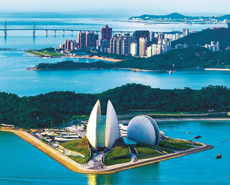Copper prices likely to fluctuate narrowly at low levels in Q1 on dim demand
----Interview with Ge Wenyu, Deputy General Manager at Eastern Copper Co., Ltd.
Shandong Jinsheng Nonferrous Metal Group Co., Ltd was established in 1993. Eastern Copper Co., Ltd, Linyi East China Nonferrous Metal Co., Ltd and so on are subsidiaries of Jinsheng Group, which is engaged in copper scrap recycling, refining, processing. Meanwhile, the group also focuses on logistics, financial investment, information technology and so on. The group has 860 employees. The company’s Yimeng brand was registered in Shanghai Futures Exchange in 2014, and the company became the first private enterprise with high-purity copper in China.
Asian Metal: Mr Ge, thanks for agreeing to this interview. Could you please give us a brief introduction to your company’s main business activities?
Ge: Shandong Jinsheng Nonferrous Metal Group Co., Ltd is mainly engaged in copper scrap recycling, refining and processing. Eastern Copper Co., Ltd is a subsidiary of Jinsheng Group with the total investment of 2.212 billion yuan. We introduced continuous rolling and casting copper rod production line from SMS meer in Germany with the capacity of 320,000tpy and refined copper production line with the capacity of 200,000tpy. In 2015, our outputs of low-oxygen copper rod reached 175,000t, up by 10,000t compared with those in 2014. Meanwhile, we produced 140,000t of copper in 2015, up from 120,000t in 2014.
Asian Metal: Copper prices on LME and SHFE kept falling, and many copper smelters said they could gain meager profits. Some major producers would cut outputs to prevent copper prices from falling. What about your company’s profits?
Ge: In recent years, copper scrap industry in China had endured hardships. The prices in the international market were higher than those in the Chinese domestic market, and many Chinese producers, who purchased copper scrap to produce copper, were forced to cut or even suspend production. Our group quickens transferring structure, and we have already purchased copper blister instead of copper scrap. Meanwhile, we purchase copper blister from domestic and overseas markets to promote industry structure. Currently, we increase copper blister imports, and the treatment charges climb in 2016. Therefore, we may gain more profits in 2016.
Asian Metal: Currently, copper rod industry in China witnesses surplus capacity, and most producers are able to generate meager profits. In 2015, Eastern Copper’s copper rod outputs continued to rise, and how does you company resolve these problems?
Ge: As far as I know, copper rod capacity in China has already exceeded 10 million tons, but China’s demand growth slows down gradually. In China, most copper rod producers face high pressure on capital turnover and low processing charges. We have some creditworthy regular customers with good risk management. Moreover, 30% of copper in Eastern Copper comes from Jinsheng Group, so we have little capital pressure.
Asian Metal: Although China’s copper rod capacity is surplus, there are 600,000t new capacity to come on stream in 2016. How do you think about it?
Ge: Copper rod supply in China exceeds the demand, and the competition become fiercer. There are many problems in copper market, like surplus capacity, low processing charges, the fluctuation of copper prices and so on. As a whole, copper rod industry may take some years to develop, and the market will develop well through deploying resources.
Asian Metal: In 2015, China’s State Grid invested 452.1 billion yuan in power grid construction, up by 17.1% year-on-year and being the highest. In 2016, the investment declined to 439 billion yuan. Will copper rod demand in 2016 weaken?
Ge: I think the decline of the investment from China’s State Grid will have little impact on copper rod demand. China’s copper rod demand mainly depends on real estate market. China’s investment on real estate market in 2015 was on the decline, but the total investment did not fall much year-on-year. Chinese government continued to adopt measures to stimulate real estate market, and it cut deed and transaction taxes after February 22, which may give a support to real estate market. Therefore, China’s demand may not shrink significantly in 2016.
Asian Metal: Since January 2016, copper prices on LME and SHFE have fluctuated narrowly at low levels. During the Spring Festival holiday, LME copper prices continued to fall. How do you think about copper price trend in Q1?
Ge: In January 2016, copper prices in London and Shanghai hit new lows in the past few years and then became relatively stable. US Federal Reserve may not be in a hurry to add interest rates, and the US dollar turned weak. Moreover, copper inventories on LME kept falling below 200,000t. In addition, China’s copper imports in January increased year-on-year, and the State Reserve Bureau would stockpile copper, which will support copper prices. However, spot copper demand is slow, and consumers hold wait-and-see attitudes towards the market. In general, China’s copper prices are likely to fluctuate with a narrow range at low levels in the first quarter of 2016.
















